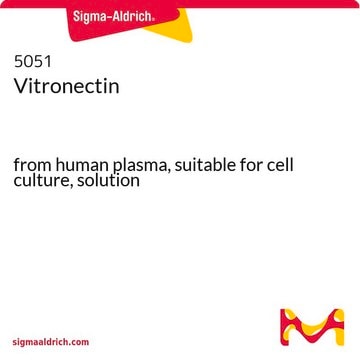V9881
Vitronectin from bovine plasma
lyophilized powder, BioReagent, suitable for cell culture
Sinónimos:
Serum spreading factor
About This Item
Productos recomendados
origen biológico
bovine plasma
Nivel de calidad
Línea del producto
BioReagent
formulario
lyophilized powder
envase
pkg of 50 μg
técnicas
cell culture | mammalian: suitable
cobertura de la superficie
0.1 μg/cm2
solubilidad
water: soluble 1.0 mL, clear, colorless
Nº de acceso UniProt
Condiciones de envío
ambient
temp. de almacenamiento
2-8°C
Información sobre el gen
bovine ... VTN(507525)
Aplicación
Acciones bioquímicas o fisiológicas
Componentes
Precaución
Nota de preparación
Código de clase de almacenamiento
11 - Combustible Solids
Clase de riesgo para el agua (WGK)
WGK 3
Punto de inflamabilidad (°F)
Not applicable
Punto de inflamabilidad (°C)
Not applicable
Equipo de protección personal
Eyeshields, Gloves, type N95 (US)
Certificados de análisis (COA)
Busque Certificados de análisis (COA) introduciendo el número de lote del producto. Los números de lote se encuentran en la etiqueta del producto después de las palabras «Lot» o «Batch»
¿Ya tiene este producto?
Encuentre la documentación para los productos que ha comprado recientemente en la Biblioteca de documentos.
Artículos
3D cell culture overview. Learn about 2D vs 3D cell culture, advantages of 3D cell culture, and techniques available to develop 3D cell models
Cancer stem cell media, spheroid plates and cancer stem cell markers to culture and characterize CSC populations.
Nuestro equipo de científicos tiene experiencia en todas las áreas de investigación: Ciencias de la vida, Ciencia de los materiales, Síntesis química, Cromatografía, Analítica y muchas otras.
Póngase en contacto con el Servicio técnico






